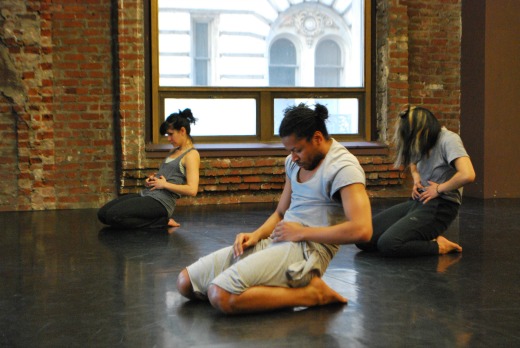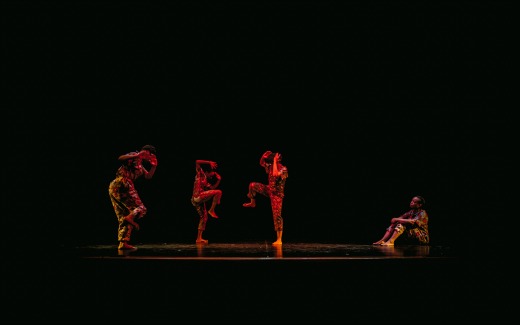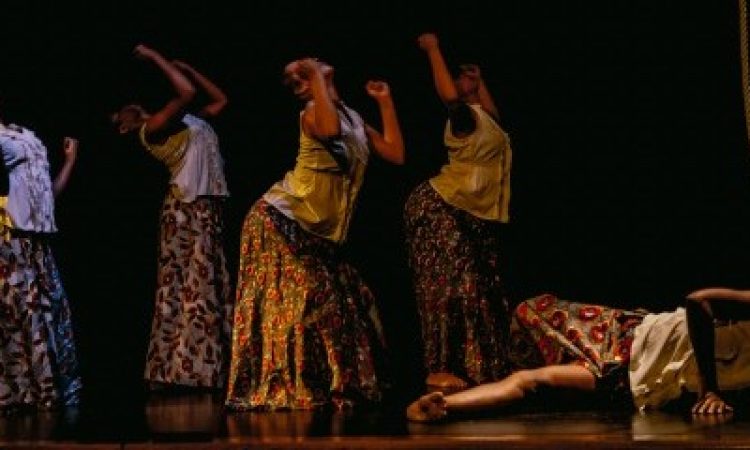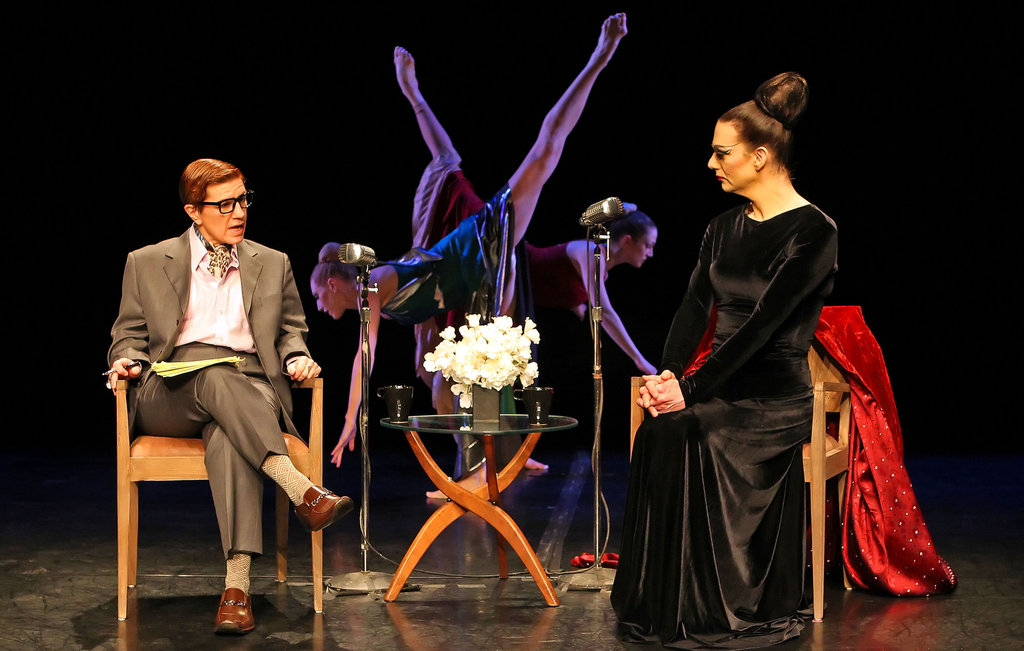A favorite Zen story tells of a wealthy local lord who visits a monk well-known for his beautiful brush paintings. The lord is ushered into the master’s room and served tea. After the painter enters, they exchange pleasantries, then the lord states the purpose of his visit—to commission a painting of a goldfish. He is told to return in three months’ time.
With that time elapsed, the lord is again ushered into the master’s room, served tea, and waits. The master enters and, before a low table with paper and ink at the ready, swiftly executes a magnificent rendering of a goldfish. The lord asked “why have you made me wait all this time?” In answer, the painter slides open a closet door and out tumble piles of such paintings.
Like the monk showing his myriad fish paintings, artists may share traces of their work’s creation: its behind-the-scenes questions, experiments, conversations, variations, refinements, all growing on the ground of past works and personal history. Three performances within the span of two weekends got me thinking about how having clues to the makers’ journey (process) can be useful in appreciating the destination (performance), or, in contrast, might sow confusion.

Reggie Wilson’s Stamped, Stomped, Stumped in the Painted Bride’s Re-PLACE-ing Philadelphia project, assembled a strong group of diverse Philly performers. Promotional text said the work would examine “how we ‘physicalize place’.” I saw dancers sharing set movement material, mostly in unison or feathery canons. Solos erupted out of the group. The performers gradually traded monochromatic costumes for colorful ones, housed on a rack they rolled around the space. Text was intermittent in a recorded sound-score of gems—assembled musical clips, most from performers with ties to Philly, some with lyrics referencing the city.
In a post-show discussion the Philadelphia audience learned that the “sharing” of personal movement—learning each other’s phrases—was an important part of the group’s process, as were many discussions about race in our city. How these conversations made a mark on the performance was not evident to this viewer. Though the cast is representative of our city’s multiple races and ethnicities (and gender identifications?) the material shared didn’t cast light on the performers’ earlier dialogue. Neither were the distinct architectural or historical features Wilson discovered through walking the city (something mentioned in the post-show talk) obviously referenced. Instead, there was a choral sameness to the performers, and a sense that their own dancing potential remained untapped*. Some exceptions offered vivid moments—David Brick’s sign language and thrashing against the walls, Kristel Baldoz’s slowly simmering solo that reached a peak of wildness, Germaine Ingram’s vocalized channeling of gospel figures. Otherwise it remained an enigma how the seven dancers’ bodies were imprinted by the city or by each other, and the movement remained unmined—raw material that seemed largely un-orchestrated, delivered mostly with dancers equidistant to each other, forgoing individuated interactions.
Seeing characters and relationships rise more fully out of the soup was possibly where this process might go, given further time. Was their time too constrained? Or was the collectivity the most salient feature of the work? A friend I spoke with the following day was, like me, looking for handholds during much of the show, wondering where the elements would coalesce. But this friend ended up deeply moved, as were many who spoke during the talk-back. Something was quickened for these folks that eluded me … perhaps watching others moving cooperatively, hearing bits of their histories in brief flashbacks.
In programming an array of work joined under one thematic umbrella, the Painted Bride has provided a number of sources—talks, readings, a dedicated website—to better understand the thrust of its Re-PLACE-ing Philadelphia performances. But for a viewer like me, coming in fresh for Wilson’s performance, despite seeking out information about it online, attending the post-show conversation, and reading the program notes, which reference individual performances but are largely general, I didn’t find the landmarks I needed to connect with this particular journey.

As a lead-in to another Re-PLACE-ing Philadelphia show, this one by Congolese dance maker Faustin Linyekula, a number of activists working in arts non-profits in North Philadelphia gathered in a circle to speak about challenges and directions forward. We learned that the very corner where the performance was taking place, at 2nd and Cambria, is the highest drug traffic area in the city, and one of the highest in the nation—that this part of town is also a hub for human trafficking.
It was a powerful choice on Linyekula’s part to move away from a conventional theater space to locate his performance Philly Files in the ruin of an old factory in this troubled North Philly neighborhood. The brick walls and beams defining expansive concrete floor areas remained largely intact, but no ceiling covered them. Instead, overhead was radiant blue sky, and workers in adjacent spaces were hauling materials and driving vehicles.
King Britt’s ever-evolving sound space was the backbone of this dance, his ensemble of four musicians making a big, rough, driving sound.
The audience was seated around a circular playing space defined by carefully-placed bricks, like a circus ring. A cluster of nine young performers from University of the Arts huddled to one side as another dancer, a wonderful mover, reveled in pure physicality, with a gentle sense of exploration. Shortly after the full group began to move I wondered—why choose a student group? To have a ready-made group of talented and diverse dancers? But in a dance that’s clearly a scored improvisation, presence is a big deal, and these young people didn’t have enough experience to settle and find real depth. I saw their self-consciousness, their noodling. In contrast, when Linyekula put down his camera (he played a role as documenter as well as performer), and erupted into a solo of shaking, he was utterly compelling. What was this volcanic power coursing through him? Was this the embodiment of all the suffering of this North Philly neighborhood? Of the disintegration talked about in the pre-show conversation as jobs left the area and people resorted to dealing drugs to feed their families?
The circle likewise disintegrated. As it was dismantled, its bricks were piled one by one on Linyekula, lying supine, ultimately buried. The young dancers, in all their activity of coming and going around this grave central act, seemed youthfully frivolous.
Like a post-apocalyptic afterward, a segment in a second space featured Linyekula’s haunting singing. He seemed to channel his own culture and its war-torn heartbreak, transposing that suffering into this problem-riddled part of our town. I sensed that he took all this feeling in as the material of his song and dance, that his body was translating it into what we saw and heard coming through him.
One question posed prior to the show, left hanging, concerned the people OF the neighborhood— how to connect further? They were not coming into the space of the performance. Perhaps the music would spill out and reach them, the commenter said, but the question hovered. Linyekula’s own artistry could certainly communicate across all kinds of boundaries.
Seeing these works brought up questions about my biases in experiencing dances. I find the realm of non-narrative work that nonetheless addresses particular subject matter the trickiest. If an artist states a clear intention in a program note or talk, I can’t help looking for that and hoping to experience not so much a statement as a feeling of cohesion, of rightness, through the work’s images. It’s frustrating to be told what I will see when that isn’t evident to me in the work.
I understand that to keep growing, artists need to place themselves with new working partners and in new contexts where a process may not arrive at a completely satisfying conclusion. Maybe an artist’s process is one that engages many questions, and the answers are not what matters. The richest experience for me as a watcher comes where the balance of revealing process is just right—somewhere between being opaque and fully transparent—where I can see or understand traces of what went into the dance that’s before me.

Six years ago I saw a work by Lela Aisha Jones that used rope tied as a noose and found it almost too painful to watch. That was the point. The noose continues to figure prominently in the first part of her show Native Portals, presented through the Intercultural Journeys series. Now, a program note explained that, as part of the process, the members of her company, Flyground, related how they first learned about noose lynching and what their responses were. Those recordings are used as soundtrack. Approaching the subject this way makes it no less horrible, but more dimensional, like a crystal turned in different directions.
We are bearing witness. This happened. This happens, albeit in a different form today. Witness the epidemic of police shootings of young black men. On the day of seeing this show, the N.Y. Times ran a magazine piece about the 14-month cover-up of the circumstances of Laquan Macdonald’s murder in Chicago along with reports on the resistance and political action taking place in response. So Jones hardly needs to supply context.
There’s no guess work here; all is explicit. Jones’ style is to play image after image, some short, for an amalgam of impressions of continuing injustice. How does she tell these stories? There’s the text on recorded audio. There are handwritten signs, like ones you’d carry in protest. She deploys her strong cast, all African-American women first dressed in outfits recalling enslaved people’s clothing, then in contemporary jumpsuits in the same boldly-patterned fabrics. The segments of the work address segregation, the sexualized fetishizing of the black female body, and racism in its many forms.
It’s like a newsreel. The one thing we can infer, that we are not told directly, is that this is art as a call to action.
Such literalness, like photo-realist painting, tells you exactly what it’s addressing, not wading into the more nebulous realms of art. It’s on the opposite end of the spectrum of work that doesn’t offer handholds.
My questions, left to ponder: When work engages questions about how we are as a culture, and aspire to be, how can those questions be made explicit in effective ways? How does an artist know how much process to share? How to best share it?
*In Notes from a Day with Tommy DeFrantz (aka Dr. Thomas F. DeFrantz) there’s this: “BLACK CULTURE HAS LESS INDIVIDUATING IMPULSE. Being connected runs through this cultural formation. Assumptions that ground the performance have to do with connectivity.” Do I misinterpret Wilson’s choices by underplaying this value?
Stamped Stomped Stumped, Reggie Wilson, Painted Bride, April 14-16. http://re-place-ing.org/content/reggie-wilson-stamped-stomped-stumped
Philly Files, Faustin Linyekula, 2nd and Cambria Streets, April 21-23. http://re-place-ing.org/content/faustin-linyekula-philly-files
Native Portals, Lela Aisha Jones/Flyground, Intercultural Journeys at International House, April 23-24. http://www.interculturaljourneys.org/lela-aisha-jonesflyground-native-portals/






